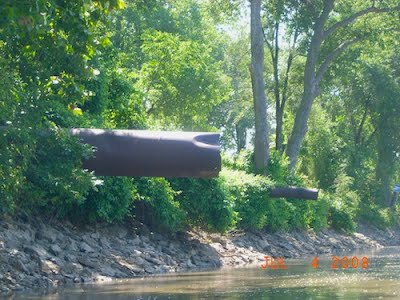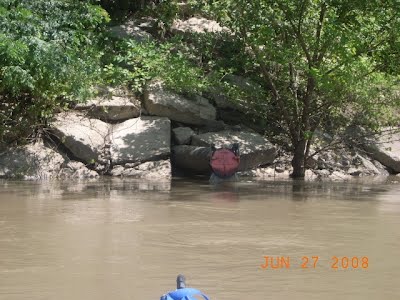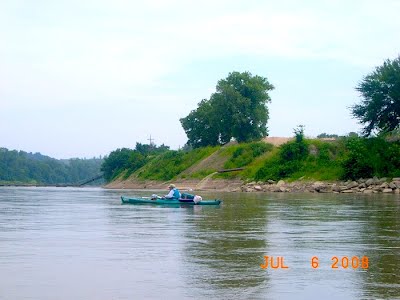 As you paddle down the Kansas River you can’t help but notice that there are a lot of pipes and conduits draining into the Kaw. These pipes carry water from municipal sewage treatment plants, combined stormwater and sewage outfalls, power plants, factories, and all kinds of business and residential sources. Water can also enter the river from man-made ditches, outflow pipes from sand dredges, and concentrated animal feeding operations. Potentially contaminated water that enters the river from an identifiable location is what we call a point source, or “end-of-pipe” pollution. The River Atlas allows you to see the location of many of the most important areas of concern which are regulated by the Kansas Department of Health and Environment and the U.S. Environmental Protection Agency.
As you paddle down the Kansas River you can’t help but notice that there are a lot of pipes and conduits draining into the Kaw. These pipes carry water from municipal sewage treatment plants, combined stormwater and sewage outfalls, power plants, factories, and all kinds of business and residential sources. Water can also enter the river from man-made ditches, outflow pipes from sand dredges, and concentrated animal feeding operations. Potentially contaminated water that enters the river from an identifiable location is what we call a point source, or “end-of-pipe” pollution. The River Atlas allows you to see the location of many of the most important areas of concern which are regulated by the Kansas Department of Health and Environment and the U.S. Environmental Protection Agency.
When water is discharged into the river, the amounts and types of pollutants that are allowed to come out of the pipe are regulated by the Clean Water Act through the National Pollutant Discharge Elimination System (NPDES) permit program. You can find out about individual NPDES permits in your area by contacting KDHE or EPA. If you are concerned about a particular discharge, contact the Kansas Riverkeeper directly to report potential violations .
Water from your home goes into a municipal wastewater facility, where it is treated and discharged into waterways. Treated municipal wastewater and wastewater from industrial facilities are discharged from pipes into streams and rivers. Such “end of pipe” pollution is called “point source pollution” and can negatively impact streams. As authorized by the Clean Water Act, the National Pollutant Discharge Elimination System (NPDES) permit program controls water pollution by regulating point sources (from pipes and ditches) that discharge pollutants into waters of the United States.
 There are many pollution source points in the Kaw watershed. Water pollution degrades rivers, making them unsafe for drinking, fishing, and swimming, sometimes getting so bad that the river can’t even support fish and other aquatic life. Regulating the amount of pollution discharged into a river is the job of the National Pollutant Discharge Elimination System, first created in 1972 with the passage of the Clean Water Act. The Kansas Department of Health and Environment (KDHE) issues NPDE permits in the state of Kansas, under the authority delegated to it by the US Environmental Protection Agency.
There are many pollution source points in the Kaw watershed. Water pollution degrades rivers, making them unsafe for drinking, fishing, and swimming, sometimes getting so bad that the river can’t even support fish and other aquatic life. Regulating the amount of pollution discharged into a river is the job of the National Pollutant Discharge Elimination System, first created in 1972 with the passage of the Clean Water Act. The Kansas Department of Health and Environment (KDHE) issues NPDE permits in the state of Kansas, under the authority delegated to it by the US Environmental Protection Agency.
Regulating the quality of the water discharged from point sources is complicated, because there may be many sources of a given pollutant, including both point and non-point sources. What goes into the river is an accumulation from all over the watershed. For example, ammonia may come from several municipal sewage treatment plants that discharge into a stretch of the river, but also from non-point sources like the fertilizer applied to golf courses and lawns in your neighborhood, as well as from farms and grazing lands in the watershed. All of these sources contribute to the ammonia in the river. Some way had to be found to regulate all of the sources in a way that reduces the total amount of ammonia that reaches the river. That was the logic behind the Total Maximum Daily Load (TMDL) process that was put in place to manage Impaired Waters (surface waters that are too polluted to attain their designated “usage”).
The State of Kansas is required by the Federal Clean Water Act of 1972 to develop Total Maximum Daily Loads for rivers, lakes and other surface waters that have been found to be impaired; in 1995, the Kansas Natural Resource Council and the Sierra Club filed a complaint against the EPA, which compelled it to enforce Section 303(d) of the Clean Water Act by establishing TMDLs. Since the state had lead responsibility for the TMDL process it intervened, and a settlement was reached in1998. The Kansas Department of Health and Environment has been working with EPA ever since to survey streams and rivers, determine what “uses” are possible, and create plans for how the pollutants will be regulated to attain the desired useage for each stream and river in the state.
 According to the Kansas Department of Health and Environment Total Maximum Daily Loads (TMDLs) are quantitative objectives and strategies needed to achieve water quality standards. The water quality standards constitute the goals of fully supporting the designated uses of streams, lakes, and wetlands. The process of developing TMDLs determines the pollutants causing water quality impairments; the degree of deviation away from applicable water quality standards; the levels of pollution reduction or pollutant loading needed to attain achievement of water quality standards; corrective actions, including load allocations, to be implemented among point and nonpoint sources in the watershed affecting the water body; the monitoring and evaluation strategies needed to assess the impact of corrective actions in achieving TMDLs and water quality standards; and provisions for future revision of TMDLs based on those evaluations.
According to the Kansas Department of Health and Environment Total Maximum Daily Loads (TMDLs) are quantitative objectives and strategies needed to achieve water quality standards. The water quality standards constitute the goals of fully supporting the designated uses of streams, lakes, and wetlands. The process of developing TMDLs determines the pollutants causing water quality impairments; the degree of deviation away from applicable water quality standards; the levels of pollution reduction or pollutant loading needed to attain achievement of water quality standards; corrective actions, including load allocations, to be implemented among point and nonpoint sources in the watershed affecting the water body; the monitoring and evaluation strategies needed to assess the impact of corrective actions in achieving TMDLs and water quality standards; and provisions for future revision of TMDLs based on those evaluations.
